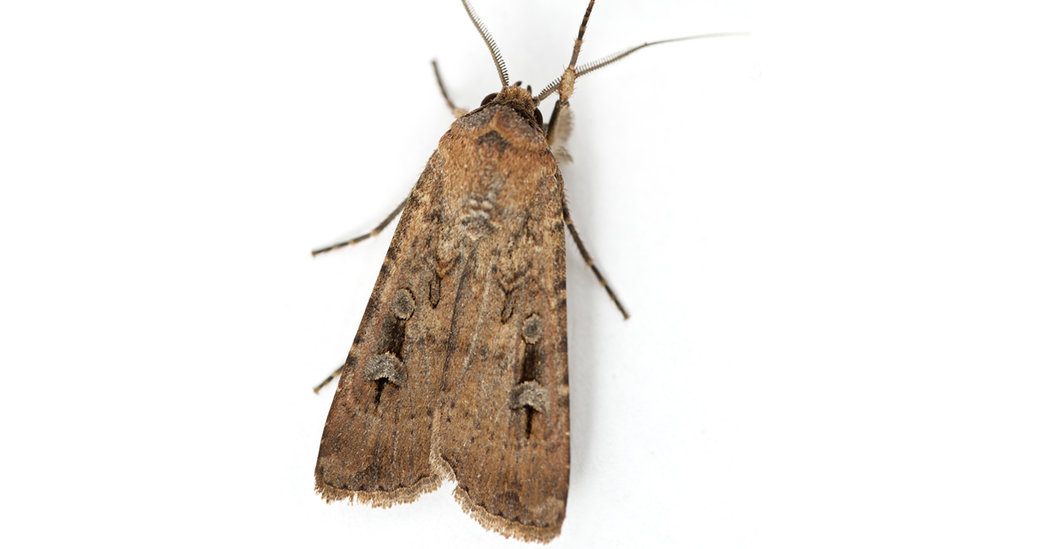
This article is more than
7 year oldHow bogong moths migrate thousands of miles using the Earth's magnetic field

Each spring, billions of bogong moths travel thousands of miles across the plains of Queensland and Victoria to the meadows of the Australian Alps.
Their preferred holiday destination, this is where the insects go to rest during the summer.
For a long time, the moth's ability to migrate such distances overnight has stumped scientists. But a recent study published in Current Biology shines a light on the mystery, with researchers saying bogong moths use the Earth's magnetic field as navigation during migration.
- AS IT HAPPENS: Newly discovered beetle masquerades as ant's backside
Eric Warrant, a professor of zoology at the University of Lund, was a principal investigator in the study. He spoke to As It Happens guest host Robyn Bresnahan about his research.
Here is part of that conversation.
Tell us about the journey of a bogong moth. Just how remarkable is it?
The journey of a bogong moth is extremely remarkable. It's a very small insect. It flies only at night and this moth emerges in the Australian spring as an adult from various regions of southeastern Australia.
When they hatch into the adult form, they make an incredible journey of around 1,000 kilometres from many different starting points.
But they end up all at the very same geographically restricted destination, which are our highest mountains in Australia just in the vicinity of Canberra, our national capital.
There are a number of high Alpine caves, and then they're there for about three or four months in a dormant state. After that time, which is over the Australian summer ... they wake up, they leave the caves and make the same journey in the opposite direction, back to where they came from.

So 1,000 kilometres for the little insect flying in the dark. How do they know where they're going?
They're coming from all different directions. So what really has been fascinating for us is: How do they know which direction to fly and when to stop?
Nobody has told them how to get to these mountains. They've never been there before. Their parents have been dead for several months. They haven't been able to pass on this information.
The latest research that we've just done, we've discovered that at least part of the answer to that question seems to lie in the fact that these moths are able to sense magnetic fields.
They have a magnetic sense, which is not absolutely unusual in the animal kingdom, but these moths use this sense to detect the Earth's magnetic field and use it as a kind of compass to find their way.
How did you test this theory?
We caught moths during their migration. We used a very big light that we shone up into the sky, and this beam of light attracted moths down onto a sheet on the ground, where we collected them in large numbers and then we took them to our experimental apparatus.
We glued a little metal stalk to their back. This little metal stalk you could hold with your fingers and they would fly very vigorously on the end of it while you held [it].
We inserted these flying moths into a flight arena ... which we placed on the table, and this moth was able to then turn in any direction that it wished in this apparatus, relative to north.
We monitored the direction that the moth flew continuously as we manipulated the animal with different kinds of sensory cues.
This is a little bit like how humans would use compasses then?
Yes, that's right. What we think we've found here is that when we've had the moth in this flight arena ... we've turned the Earth's magnetic field to a new direction.
So normally it's directed north-south, but we had the ability to turn the field in any direction we wished within the arena.
Using this and also using visual landmarks in the arena, we could show that the moths seemed to be able to use those cues together as a way of finding their direction towards the mountains.
Why is this important?
I think the thing that we find most amazing about this discovery is that we already have known for some time that night-flying birds that migrate over huge distances across the surface of the Earth also rely on the ability to sense the Earth's magnetic field as a compass cue.
But they have a very big, very large nervous system.
So in a small nocturnal migrating moth, with a very small nervous system and an extremely small brain ... the fact that this small animal is able to do the same thing, it's quite an amazing finding.
Written and produced by Samantha Lui. Q&A has been edited for length and clarity.
MORE FROM THIS EPISODE
- How bogong moths migrate thousands of miles using the Earth's magnetic field
- Motorcycle crash victim's mom uses son's eulogy to deliver powerful warning about speeding




